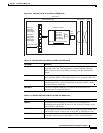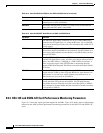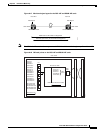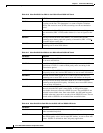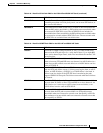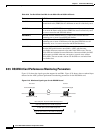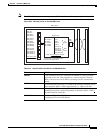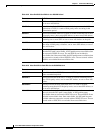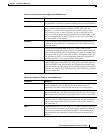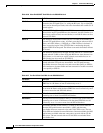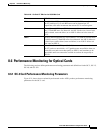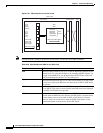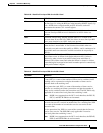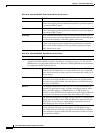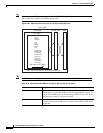
8-31
Cisco ONS 15454 Installation and Operations Guide
November 2001
Chapter 8 Performance Monitoring
Performance Monitoring for Electrical Cards
Table 8-24 Near-End DS1 Path PMs for the DS3XM-6 Card
Parameter Definition
DS1 AISS-P
Alarm Indication Signal Path (AIS-P) means an AIS occurred on the path.
This parameter is a count of seconds containing one or more AIS defects.
DS1 ES-P
Errored Seconds Path (ES-P) is a count of the seconds containing one or
more anomalies and/or defects for paths. For DS1-ESF paths, this
parameter is a count of one-second intervals containing one or more
CRC-6 errors, or one or more CS events, or one or more SEF or AIS
defects. For DS1-SF paths, the ES-P parameter is a count of one-second
intervals containing one or more FE events, or one or more CS events, or
one or more SEF or AIS defects.
DS1 SAS-P
Severely Errored Seconds Path Frame/Alarm Indication Signal (SAS-P) is
a count of one-second intervals containing one or more SEFs or one or
more AIS defects.
DS1 SES-P
Severely Errored Seconds Path (SES-P) is a count of the seconds
containing more than a particular quantity of anomalies and/or defects for
paths. For the DS1-ESF paths, this parameter is a count of seconds when
320 or more CRC-6 errors or one or more SEF or AIS defects occurs. For
DS1-SF paths, an SES is a second containing either the occurrence of
eight FEs, four FEs, or one or more SEF or AIS defects.
DS1 UAS-P
Unavailable Seconds Path (UAS-P) is a count of one-second intervals
when the DS1 path is unavailable. The DS1 path is unavailable when ten
consecutive SESs occur. The ten SESs are included in unavailable time.
Once unavailable, the DS1 path becomes available when ten consecutive
seconds occur with no SESs. The ten seconds with no SESs are excluded
from unavailable time.
Table 8-25 Near-End VT PMs for the DS3XM-6 Card
Parameter Definition
CV-V
Code Violation VT Layer (CV-V) is a count of the BIP errors detected at
the VT path layer. Up to two BIP errors can be detected per VT
superframe; each error increments the current CV-V second register.
ES-V
Errored Seconds VT Layer (ES-V) is a count of the seconds when at least
one VT Path BIP error was detected. An AIS-V defect (or a lower-layer,
traffic-related, near-end defect) or an LOP-V defect can also cause ES-V.
SES-V
Severely Errored Seconds VT Layer (SES-V) is a count of seconds when
K (600) or more VT Path BIP errors were detected. An AIS-V defect (or
a lower-layer, traffic-related, near-end defect) or an LOP-V defect can
also cause SES-V.
UAS-V
Unavailable Seconds VT Layer (UAS-V) is a count of the seconds when
the VT path was unavailable. A VT path becomes unavailable when ten
consecutive seconds occur that qualify as SES-Vs and continues to be
unavailable until ten consecutive seconds occur that do not qualify as
SES-Vs.



